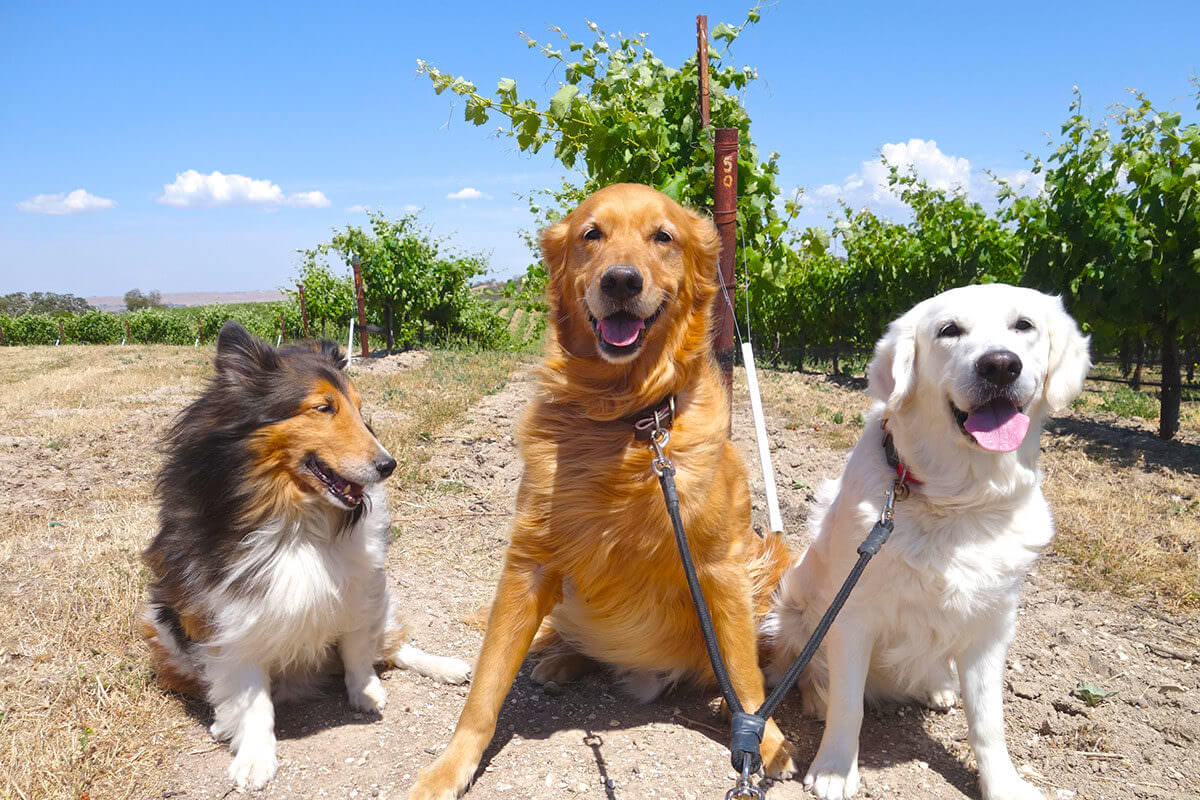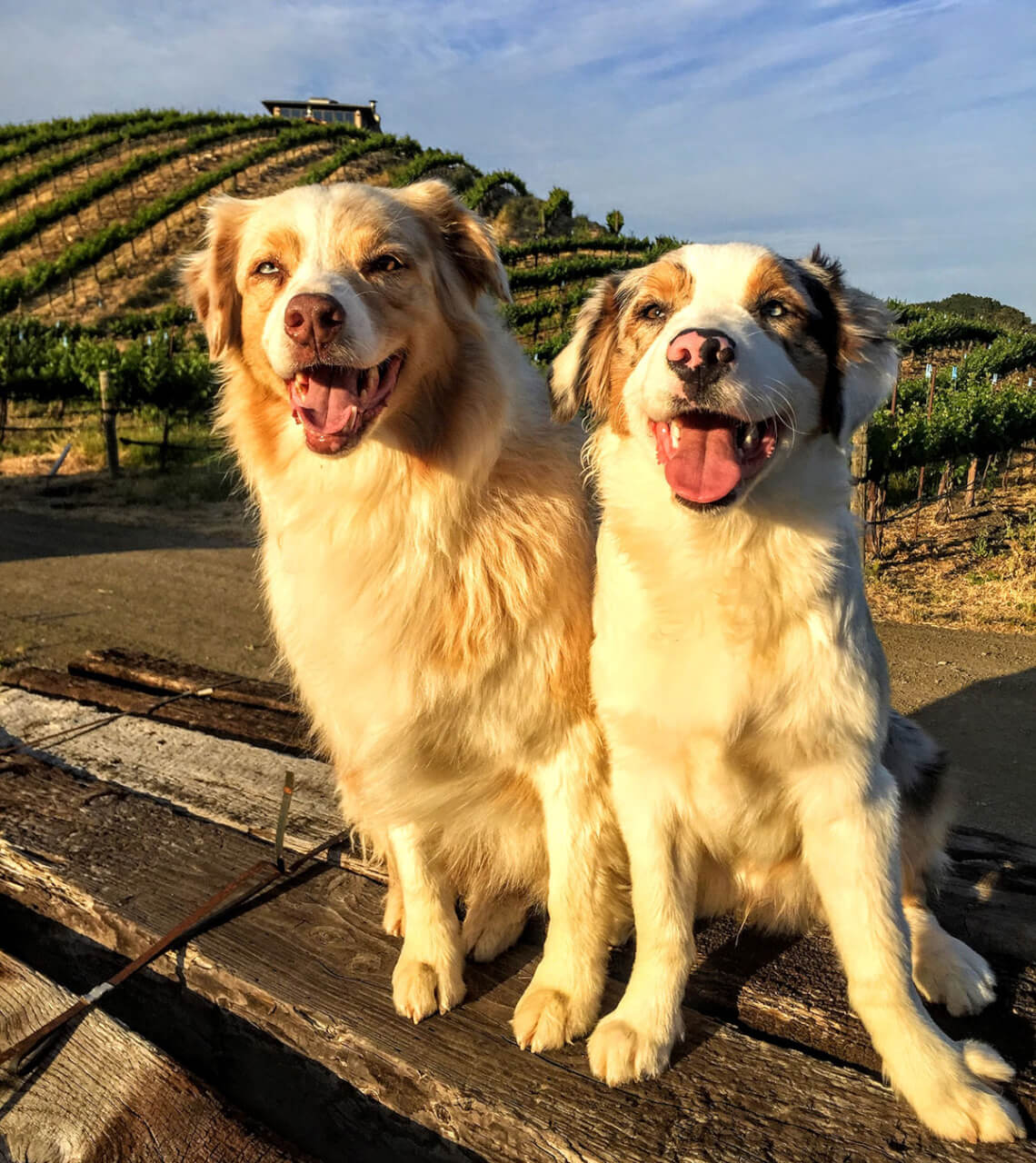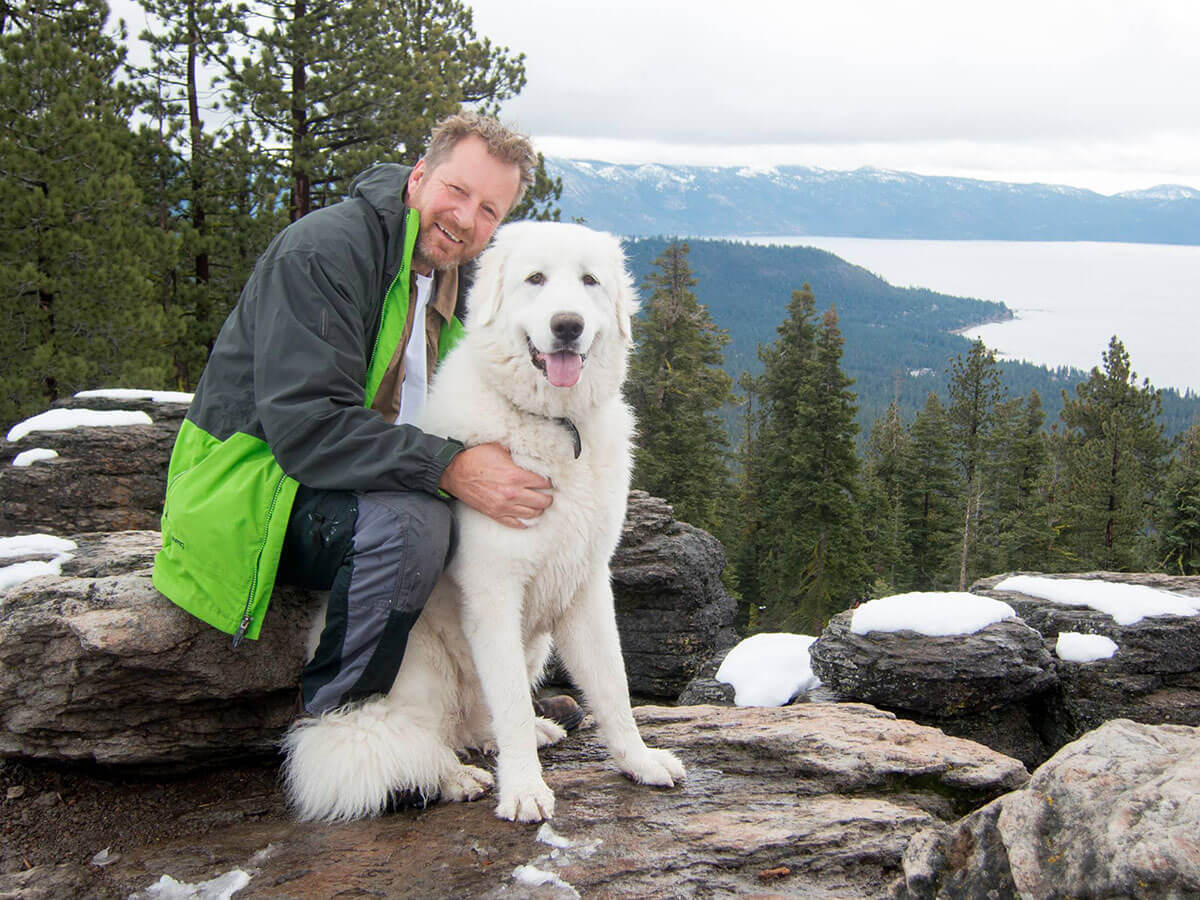5 Reasons Every Winery Needs a Dog
From protecting weed-eating sheep to sniffing out devastating disease, these dogs help keep the wine flowing.
5 Reasons Every Winery Needs a Dog
From protecting weed-eating sheep to sniffing out devastating disease, these dogs help keep the wine flowing.

Kula Winery's name is in honor of the owner's two golden retrievers (right). "Kula" means "golden" in some Hawaiian languages. Photo courtesy of Kula Winery
It seems a winemaker’s best friend may be their Weimaraner. Or perhaps their border collie, Labrador, or that adorable rescue. Almost any pooch, in fact, can be a huge asset when it comes to operating a vineyard—and not just when it comes to charming visitors.
Dogs can help protect other animals, sniff out pests and keep critters away from grapes before harvest, helping vineyards to cut down on the use of machinery, pesticides and other chemicals.
California—which produces about 90 percent of domestic wine—has some of the hardest-working canines around. Here, their owners share why they believe every winery should have a dog.
1. They Can Detect Vine Diseases
At Honig Vineyards in Napa Valley, Honey, a Labrador retriever, is learning to sniff out a disease that can devastate entire vineyards.
The owners are working with the Bergin University of Canine Studies in Rohnert Park, California—the only accredited U.S. university specializing in learning about and training dogs.
During a trial in 2008, researchers at Bergin trained sniffer dogs to detect grapevine mealybug that feed at the bases of shoots, preventing fruit growth. The bugs can also cause the spread of grapevine leafroll virus, which can dramatically reduce crop yield.
Now the Honig family has hired a trainer currently studying at the university to prepare Honey for new job as a disease detecter.
Stephanie Honig said: “Honey’s job is very specific – detecting the scent of the grapevine mealybug in a vineyard. If a vineyard has the bug it’s devastating to the vine. We don’t have it at Honig, but it does exist in some surrounding grape-growing areas.”
This practice also fits with sustainable winemaking, she added.
“If a dog detects a bug, pesticides are not needed since the infected vine is removed.”
Dr. Bonnie Bergin, the university’s founder and president, told us there is far more interest from vineyard owners now than back in 2008, when many preferred to stick to cheaper but inorganic forms of pest control.
“Sustainable organic vineyard management has become a more financially rewarding pursuit than in 2008, and the vine mealybug problem has increased over the intervening years. As such Bergin University intends to introduce its Canine Vine Mealybug Scent Detection Project into its current year curriculum,” she said.
Honey has another crucial role. She is being trained as a diabetic alert dog for the owners’ nine-year-old daughter, who has type 1 diabetes.
“The goal is that she be dually-trained, which has never been done before,” added Stephanie.
Read More
Is My Dog Food Sustainable?
2. They Watch The Flock
At Navarro Vineyards in the Anderson Valley, a flock of sleep graze the fields, removing the need for weedkiller. But they couldn’t do their job without Navarro’s four working dogs—rescue mutt Ferb, an Anatolian called Dash, and Kuvasz-Maremma cross breeds Bella and Regina—whose main job is to keep them safe.
“The dogs protect the animals from wildlife like wild pigs and mountain lions,” said Karin Strykowski, Navarro’s PR manager. “Whenever we see tracks, our vineyard workers want the dogs.”
The winery is also home to two retirees, a Maremma and a Great Pyrenees. After a few years of hard work, Pecorina and Cappo now just hang out on the ranch.
3. They Keep Vine-Munchers at Bay

Dogs can also be beneficial when it comes to spooking deer, which can wreak havoc by stripping the vines.
Chris Behr, owner of Oso Libre Winery and Ranch in Paso Robles, has a pair of Australian Shepherds, Ruby and Brix, who do just that (the latter named for the system of measuring grapes’ sugar content).
Their other tasks include herding the sheep and alpaca, which eat weeds and fertilize the vines in winter, and catching vineyard enemies such as gophers and squirrels.
“Often a stray deer will get into our vines only to regret it immediately as it is quickly escorted out,” said Chris. “In January, we then use our Aussies to move our Angus herd in and out of the vineyard to work with the sheep and alpacas for limited hours per day, as cows eat far more per hour. This fattens up our future beef and controls our vine rows, allowing us to stay off our tractor saving time, fuel, herbicides and fertilization needs.
“We are SIP (Sustainability in Practice) certified as a result of these techniques, and our Aussies are an integral part of this process. They definitely work for a living and live to work. A working ranch and winery without working dogs is not working on all cylinders, in our opinion.”
Learn More
Livestock guardian dogs can do important work on farms. But they are being surrendered and euthanized in epic numbers.
4. They Make Lovely Labels
The dogs of Kula Vineyards & Winery in Templeton, CA inspire not only the business’s name, but also it’s look. Kula, which means “golden,” was chosen in honor of the owners’ two Golden Retrievers, Ehime and Kona. The pups are also featured on the wine labels, along with other furry family members.
“We asked our label designer to include them because dogs have always been a big part of our life, and when we started our vineyard and winery, it only made sense that they be a big part in that as well,” said Ayako, who owns the vineyard with husband Chris.
But mutts at more than mascots at Kula. The Williams also have a Shetland Sheepdog, Kahlua, who has a sixth sense when it comes to winged invaders, which will can strip the vines of fruit before harvest.
“Kahlua is almost 13 years old. He can’t hear much now, but he can still see and smell very well,” said Ayako. “One evening, many little birds flew over to our vineyard. Kahlua’s tail started to go up slowly and he barked like crazy at them. The birds who tried to land on the vines flew away.”
Most vineyards in the Central Coast area have dogs, Ayako added, both as companions and workers.
“Our neighboring vineyard’s dog is outside day and night. He chases after deer in the evening and barks at coyotes at night, protecting the property from animals.”
5. They Are Great at Boosting Sales
All dog lovers know what charmers their pets can be. Throw them into the mix with a sunny, vine-combed landscape and award-winning wines, and you have a winning combination.

Damian Grindley, founder and winemaker at Brecon Estate in Paso Robles, has a “big white fluffy” Great Pyrenees called Millie and a Border Collie cross, Roy.
And he reckons they’re top dogs when it comes to selling bottles of Syrah and Albariño to those who stop by the tasting room.
“Funnily enough the dogs sell more wine than we do,” said Damian. “They certainly work the crowd. Really it’s part of making customers feel at home.”
Millie does have another job aside from entertaining customers, keeping mountain lions and coyotes at bay. “Her nocturnal bark can rattle the windows in their frames,” said Damian.
But most of all, he added: “We just love our dogs.”
Follow us

This work is licensed under a Creative Commons Attribution-NoDerivatives 4.0 International License.
Want to republish a Modern Farmer story?
We are happy for Modern Farmer stories to be shared, and encourage you to republish our articles for your audience. When doing so, we ask that you follow these guidelines:
Please credit us and our writers
For the author byline, please use “Author Name, Modern Farmer.” At the top of our stories, if on the web, please include this text and link: “This story was originally published by Modern Farmer.”
Please make sure to include a link back to either our home page or the article URL.
At the bottom of the story, please include the following text:
“Modern Farmer is a nonprofit initiative dedicated to raising awareness and catalyzing action at the intersection of food, agriculture, and society. Read more at <link>Modern Farmer</link>.”
Use our widget
We’d like to be able to track our stories, so we ask that if you republish our content, you do so using our widget (located on the left hand side of the article). The HTML code has a built-in tracker that tells us the data and domain where the story was published, as well as view counts.
Check the image requirements
It’s your responsibility to confirm you're licensed to republish images in our articles. Some images, such as those from commercial providers, don't allow their images to be republished without permission or payment. Copyright terms are generally listed in the image caption and attribution. You are welcome to omit our images or substitute with your own. Charts and interactive graphics follow the same rules.
Don’t change too much. Or, ask us first.
Articles must be republished in their entirety. It’s okay to change references to time (“today” to “yesterday”) or location (“Iowa City, IA” to “here”). But please keep everything else the same.
If you feel strongly that a more material edit needs to be made, get in touch with us at [email protected]. We’re happy to discuss it with the original author, but we must have prior approval for changes before publication.
Special cases
Extracts. You may run the first few lines or paragraphs of the article and then say: “Read the full article at Modern Farmer” with a link back to the original article.
Quotes. You may quote authors provided you include a link back to the article URL.
Translations. These require writer approval. To inquire about translation of a Modern Farmer article, contact us at [email protected]
Signed consent / copyright release forms. These are not required, provided you are following these guidelines.
Print. Articles can be republished in print under these same rules, with the exception that you do not need to include the links.
Tag us
When sharing the story on social media, please tag us using the following: - Twitter (@ModFarm) - Facebook (@ModernFarmerMedia) - Instagram (@modfarm)
Use our content respectfully
Modern Farmer is a nonprofit and as such we share our content for free and in good faith in order to reach new audiences. Respectfully,
No selling ads against our stories. It’s okay to put our stories on pages with ads.
Don’t republish our material wholesale, or automatically; you need to select stories to be republished individually.
You have no rights to sell, license, syndicate, or otherwise represent yourself as the authorized owner of our material to any third parties. This means that you cannot actively publish or submit our work for syndication to third party platforms or apps like Apple News or Google News. We understand that publishers cannot fully control when certain third parties automatically summarize or crawl content from publishers’ own sites.
Keep in touch
We want to hear from you if you love Modern Farmer content, have a collaboration idea, or anything else to share. As a nonprofit outlet, we work in service of our community and are always open to comments, feedback, and ideas. Contact us at [email protected].by Ella Buchan, Modern Farmer
September 15, 2017
Modern Farmer Weekly
Solutions Hub
Innovations, ideas and inspiration. Actionable solutions for a resilient food system.
ExploreExplore other topics
Share With Us
We want to hear from Modern Farmer readers who have thoughtful commentary, actionable solutions, or helpful ideas to share.
SubmitNecessary cookies are absolutely essential for the website to function properly. This category only includes cookies that ensures basic functionalities and security features of the website. These cookies do not store any personal information.
Any cookies that may not be particularly necessary for the website to function and are used specifically to collect user personal data via analytics, ads, other embedded contents are termed as non-necessary cookies.
Do you have any issues with your dogs eating any of the grapes? I would like to grow grapes around my house, but am worried my dog may try to eat the grapes. Knowing that grapes are toxic to dogs. Thank you!
Same question as Paul – what about the dogs eating the toxic grapes?